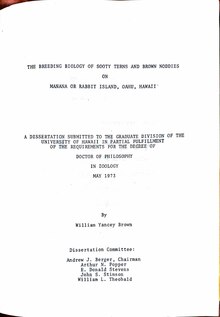Talk:Sooty tern
| This article is rated Start-class on Wikipedia's content assessment scale. It is of interest to the following WikiProjects: | |||||||||||||||||||||||||||
| |||||||||||||||||||||||||||
Replaced older small image[edit]

Replaced older small image with newer larger image. Sabine's Sunbird talk 06:57, 15 June 2006 (UTC)
Role In Easter Island Culture[edit]
This section should reflect the fact that this egg-finding ritual developed as a result of a social collapse. See Keegan, A History Of Warfare. — Preceding unsigned comment added by Maurizio689 (talk • contribs) 05:32, 30 November 2011 (UTC)
Life on Fire episode[edit]
- Pioneers of the Deep
- In the Tongan archipelago, the sooty tern and the Alvin shrimp cope when an underwater volcano becomes an island. Directed by Bertrand Loyer and released in 2010. Original title: Naissance d'Une Ile.[1]
- PBS first broadcast date: 6 February 2013.[2] — Preceding unsigned comment added by 96.237.4.73 (talk) 23:13, 14 February 2013 (UTC)
The Life on Fire episode says that Sooty Terns can fly for years without "landing" (just dipping into the water to catch food), even sleeping while flying. They sometimes eat squid. They are attracted to fish bait-balls herded up by aquatic predators, that force a school of targeted fish up to the surface.
They do not have oils on their feathers, and can drown if they get wet -- despite living on fish they catch on the surface of the open ocean.
They only need to land to nest. It says that they are particularly attracted to volcanic islands, despite the danger. That rats are a serious threat (to the eggs), forcing them to abandon areas that have rats.
To the extent these factoids can be shown true, they should be incorporated into the article.-96.237.4.73 (talk) 23:08, 14 February 2013 (UTC)
References
- ^ Pioneers of the Deep Internet Movie Database. Retrieved: 2013-01-02.
- ^ LIFE ON FIRE: Pioneers of the Deep PBS Pressroom. Retrieved: 2013-01-02.
Needs revision on the number of eggs laid by the Sooty Tern[edit]
The current article states under Ecology:
"It nests in a ground scrape or hole and lays one to three eggs."
I would like to substitute this current text with this:
"It nests in a ground scrape or hole and lays a single egg, typically in the afternoon. [1] Although "two-egg clutches" have been reported, they probably occur when an egg from one nest rolls into another.[2]"
I recommend this change because the Sooty Tern is generally reported to lay just one egg (see, for example, the Audubon Guide to North American Birds at https://www.audubon.org/field-guide/bird/sooty-ternsee, and the citation in the current text statement is to a passage about the Sooty Tern in a general online article on the Dry Tortugas.
I studied Sooty Tern eggs laying in Hawaii and authored the two articles cited in my suggested revision in peer reviewed scientific journals on the topic, including the number of eggs laid and the time of laying. I addressed the very infrequent multiple eggs clutches observed in the second article and showed, to put it simply, that they appeared to occur when a egg from a nearby nest rolled into another. The number of eggs laid is a fundamental aspect of breeding biology and it is unfortunate to have this article get it wrong. I would like to correct this error in the article, but since I am the author of the study I understand that under Wikipedia practice it is better for someone else to post this revision (assuming they agree with it). Please would someone do that. I do not believe it is in any way controversial; just a question of accuracy. Pelucidity (talk) 14:09, 18 September 2022 (UTC)
References
- ^ Brown, William Y. (1977). "Temporal Patterns in Laying, Hatching and Incubation of Sooty Terns and Brown Noddies". JSTOR. Retrieved 6 August 2022.
{{cite web}}: CS1 maint: url-status (link) - ^ Brown, William Y. (1975). "Artifactual Clutch Size in Sooty Terns and Brown Noddies". JSTOR. Retrieved 6 August 2022.
{{cite web}}: CS1 maint: url-status (link)
- Looks good to me. I'll make the edit, and update the refs you provided to be
{{cite journal}}, since both of your refs come from journals. Take a look in a bit to see the improvement. - UtherSRG (talk) 15:10, 18 September 2022 (UTC) - Ok, done! - UtherSRG (talk) 15:18, 18 September 2022 (UTC)
- Looks great! Thank you! Pelucidity (talk) 18:57, 18 September 2022 (UTC)
Adding as a reference a 1973 PhD dissertation on the breeding biology of the Sooty Tern and Brown Noddy in Hawaii[edit]
I used Adobe Scan this morning to make a PDF of this Ph.D. dissertation. Despite its age, I think it has more detail on the breeding biology of the Sooty Tern (as well as the Brown Noddy) in the Pacific than any other study. Some articles based on it have been published but much information in the dissertation was not. I know this because I am the author of the dissertation. I'd like to add it as a reference here and for the Brown Noddy so people can have ready reference to it. But, following Wikipedia practice I know it would be better for someone else to do that. I am uploading the PDF here and ask if someone might do that. I just added the document to Wikimedia Commons. Here is the HTML link: https://commons.wikimedia.org/wiki/File:Breeding_Biology_of_Sooty_Terns_and_Brown_Noddies_on_Manana_Istand,_Hawaii.pdf
And here is the text for using the file in a wiki:

Pelucidity (talk) 23:01, 22 December 2023 (UTC)
- This is Pelucidity again. Seeing no comment, and thinking this is not in any way a controversial addition to the references, I've added it to the article. However, if anyone is concerned, please let me know and I will remove it. Pelucidity (talk) 22:23, 23 December 2023 (UTC)



